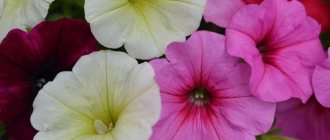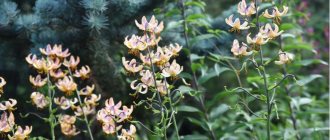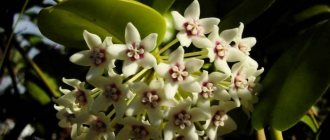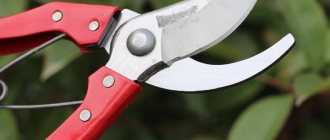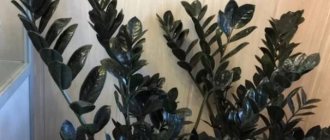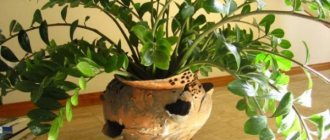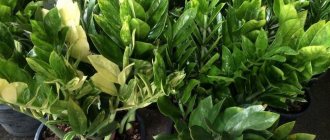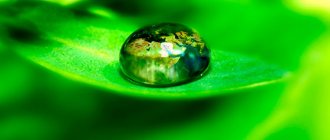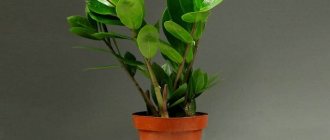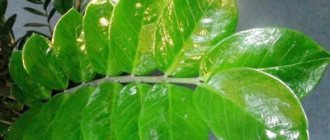Zamioculcas is a tropical plant from eastern Africa. Today it has spread all over the world, and this is due to its ease of care, but most importantly, its amazingly beautiful, decorative appearance. The flower is very often used in the design of modern interiors and perfectly complements even the most daring design solutions.
However, this plant not only has an interesting appearance, but also an equally fascinating history of its origin, and then its spread in indoor floriculture. Today this plant is known under such “folk” names as money tree or celibacy flower, and all these famous nicknames did not arise out of nowhere, but on the basis of many years of observations by different people.
Botanical description
The very first descriptions of Zamioculcas date back to the beginning 19th century . However, the plant received an accurate and generally accepted classification only in 1828, when the famous British botanist Conrad Loddiges described the structure and shape of Zamioculcas in his works. For the great similarity of the leaves of Zamioculcas with the already known at that time Zamia - a representative of the flora from the tropics of America - it was given the name Caladium Zamielifolia.
In 1856 the name of the flower was changed to Zamioculcas Loddiges. And only in 1908 it was finally renamed as it is known today - Zamiokulkas Zamielistny.
This plant is a succulent . The main reserves of water are stored in the roots. It is tuberous in shape with small shoots.
The plant develops thick, juicy evergreen leaves of regular shape. In different varieties they may differ in size: small but frequent or, conversely, large but rare. As a rule, they grow in a round shape.
The plant rarely reaches more than one and a half meters in height. Although in 2006 a decorative species was bred, which stops its growth, reaching only 40-50 cm in height.
Trimming
Pruning is not a prerequisite for proper plant care. It is carried out only to give it a certain shape or rejuvenation. You can trim any part of the plant: tuber, leaves, cuttings. The main thing is that the pruning tool is very sharp and sterile. A scalpel, garden pruning shears, and a sharp knife will do.
Also read: Aeonium home species with photos, maintenance and care
The cut area must be sprinkled with crushed activated carbon. This will quickly stop the leakage and block access to the “wound” for pathogenic microorganisms. Often pruning is used to treat the currency tree.
Plant structure
The most famous characteristic of Zamioculcas is its unpretentiousness. It is connected with the fact that the flower is classified as a succulent - that is, it has special tissues that store water in case of drought.
The bulk of the reserve moisture accumulates in the leaf cuttings, as well as in the root.
Roots
The roots of this flower are tuberous in shape with small lateral and lower shoots. It is in the tuber that the formation of most of the plant’s water reserves occurs.
They have a bright yellow or pale gray hue and form faster than the above-ground part of the flower. Zamioculcas strives first of all to entangle the entire earthen lump in the pot in order to quickly take water and nutrients from the soil, and only then directs the excess micro and macroelements obtained into the growth of green mass.
Leaves
The leaves are fleshy and dense.
At their base, closer to the root, moisture is stored in case of drought. The cuttings of each small leaf are attached to the false stem part, which rises vertically upward from the root. Interesting! In fact, Zamioculcas does not form stems at all.
In fact, leaves begin to grow from the root itself. They just have such a complex structure that some may get the impression that their base is the stem. The leaf blades are often formed quite small, which is why the flower itself has become so widespread in decorative floriculture. They retain their green color throughout the life of the flower. Only occasionally can leaves dry out and fall off, but this is either due to the plant being too dry (for example, it spends too much time in the sun) or insufficient watering.
It is also worth remembering that Zamioculcas leaves need to be wiped more often, as their waxy coating attracts dust. As an alternative method of cleaning a flower, some gardeners prefer water procedures - gently washing the plant under the shower.
Zamioculcas is a succulent plant. But its juice is very poisonous. For this reason, you should only cut leaves while wearing rubber gloves, and after every simple wiping of the flower, be sure to wash your hands. In its normal state, the plant is not capable of causing harm, but as a precaution, children or pets should not be allowed near it.
Note! If the juice gets on the skin or mucous membranes, the affected area should be immediately rinsed with warm water. If the juice gets into your mouth, it is better to take a couple of tablets of activated carbon. In case of a particularly severe reaction to the flower juice, it is recommended to consult a doctor as soon as possible.
Flowers
It is extremely difficult to achieve Zamioculcas flowering at home. To do this, you will have to achieve an almost ideal combination in terms of lighting, watering, fertilizing, and transplanting.
But the flowers themselves are quite discreet. They are a small ear of a dense white inflorescence, protected by a blanket of leaf blades.
Interesting! Due to the small attractiveness of Zamioculcas flowers, gardeners often immediately carefully cut off the formed flower so that it does not consume excess plant resources.
By the way, the shape of the flowers is very reminiscent of a human figure (the flower itself) dressed in a dress (the covering leaf blade). This is where symbolism found its place, because people began to call the plant the flower of celibacy, believing that the female owner of Zamioculcas would be able to get married only after flowering. Therefore, it is not customary to give it to unmarried ladies.
Fruit
It is difficult to get the money tree to bloom. Needless to say, it is even less common for a flower to bear fruit at home.
In nature, a single-seeded berry is formed from a flower. It is very similar in shape to a flower, but has a denser structure. In color, it is most often painted white or cream. But on some species the fruits are formed close to dark brown in color.
In indoor floriculture, almost no one succeeds in getting seeds to ripen. And the seed method of propagating Zamioculcas is rarely used. The fastest and easiest way to grow a new flower is from a cutting or a separated leaf.
Diseases and pests
Zamioculcas leaves die. Leaves may die from mechanical damage.
Zamioculcas stretches out. The plant stretches if it does not have enough light.
Zamioculcas falls off. The lower leaves may fall off - this is normal.
Spots on Zamioculcas leaves. Dark spots may appear on the leaves of Zamioculcas - this can be caused by a number of reasons: excessive watering, cold air, drafts.
Zamioculcas is rotting. The stem and roots may begin to rot if the temperature is low and the pot does not drain well.
Zamioculcas pests. Zamioculcas is not very susceptible to pest damage, but can be attacked by aphids and scale insects.
Homeland of Zamioculcas
In the wild, Zamioculcas grows only in East Africa. The largest number of different varieties is recorded on the island of Madagascar.
The plant is most often found in the shade, although it can tolerate even severe drought. Some bushes can be found in full sun. Although the greatest species diversity is observed in the African steppes, rich in grass diversity.
Despite the tropical climate of its homeland, Zamioculcas is widespread in indoor floriculture even in the northern regions of the planet. Basically, this was due to the unpretentiousness of the flower, its ability to tolerate even extremely unfavorable conditions.
Today, Zamioculcas is very often an integral part of the decoration of modern interiors. It is valued for its exotic appearance, the evergreen nature of its leaves, and the dense, solid structure of the foliage that covers it.
The plant became most widespread after it began to be presented at numerous exhibitions starting from the end of the 20th century. Moreover, such exhibitions concerned not only floriculture, but also all kinds of interior solutions.
History of indoor culture
The first description of Zamioculcas dates back to 1828, and was given by the very famous foreign collector of tropical crops, Conrad Lodges. The plant was described as Caladium zamiifolium Lodd. More than twenty years later, Heinrich Wilhelm Schott changed this name to Zamioculcas Loddiges. And a few decades later, the director of the Berlin Botanical Garden, Adolf Engler, registered the modern, latest and more famous version of the name Zamioculcas zamiifolia today.
This evergreen tropical plant became popular as a decorative indoor crop twenty years ago, after appearing at foreign flower auctions. Ten years ago, the first miniature cultivar of Zamioculcas was obtained , forming a very compact plant no more than 0.5 m high with fairly small but attractive foliage.
Interesting Facts
- Dollar tree is not the only popular nickname for Zamioculcas. It is also called the Tree of Luck, although for many people luck and money are concepts quite close to each other.
- But the plant also has a not so pleasant reputation. It is also popularly known as the flower of celibacy. It is believed that it attracts envious people and ill-wishers, so women are often afraid to keep Zamioculcas at home. On the other hand, they believe that after the flower blooms, all adversities are “reset.” However, the trouble is that flowering of this plant is difficult to achieve, and it occurs late, already at the end of Zamioculcas’s life.
- It is because of this unpleasant sign that if you want to give Zamioculcas as a gift, then it is customary to do this exclusively to men or married women.
About precautions
Zamioculcas is a poisonous plant.
Therefore, he is not afraid of all kinds of parasites and parasites.
its juice and sprouts are unlikely to kill anyone, but they will cause a lot of trouble. Calcium oxolate contained in the plant is a fairly strong allergen for humans.
When working with Zamioculcas, certain precautions must be taken. This is especially true for the treatment of tubers when dividing for propagation. Quite large roots can splash their juice not only onto the hands of the unfortunate owner, but also onto the mucous membranes.
Cutting a leaf with drops of poisonous liquid
In addition, to wash, for example, your eyes from the poison of this plant, you need to spend enough time, since calcium oxide does not dissolve well in water. Therefore, when working with Zamioculcas, it is necessary to wear plastic protective gloves and goggles. Whether you're pruning branches or dividing tubers, you need to wear protective gloves.
Pets - cats and dogs - ignore Zamioculcas because their sense of smell suggests it is poisonous, but with birds the situation is a little more complicated.
It is not recommended to place a pot with zamioculcas in a room where parrots can fly. They may be attracted to succulent branches, and if the parrot eats the flesh of the plant, it may die.
a whimsical and unpretentious indoor plant. Despite its slow growth, it has taken a strong place in modern floristry. And its fantastic endurance and unpretentiousness allows it to be grown in almost any conditions. This plant can be used as a wonderful gift for an experienced or novice gardener, or even for a completely inexperienced person with indoor plants. Since the pot is of sufficient size, the plant only needs watering, so a person completely inexperienced in floriculture can take care of it.
Flower varieties
In natural conditions of the wild, only one species of Zamioculcas grows called Zamioculcas Zamielifolia.
The plant gained popularity for indoor cultivation at the end of the 20th century. People were attracted by the unusual shape of the leaves and the relative unpretentiousness of the flower. Today, several varieties of plants are the most widespread and are preferred for growing in homes, offices, and public spaces.
- Zamioculcas Lanceolata ( Lanceolata ) , the main feature of which is considered to be pronounced leaves with large blades in width and length.
- Zamioculcas Variegata . This is a rather rare variety, the main characteristic feature of which is the variegated color of the leaves, pointed at the edges. The variety grows up to 1-1.5 meters in height.
Also, for a long time, the variety Zamioculcas Buevena was isolated, which was later classified as a different genus of plants.
Growing
These are low-maintenance and slow-growing tropical semi-succulents. These plants do not require special care indoors, as they can grow in almost any environmental condition. They are a suitable choice for owners who sometimes neglect or forget about them.
Light
These plants like bright and indirect light, but they can also grow normally when placed in rooms or areas with low light levels. However, when Zamioculcas plants experience long periods of shade, their growth rate slows down significantly.
Temperature
They will have a great time in warm, comfortable conditions for humans. The ideal temperature for their healthy growth is 15-24°C. These plants are quite sensitive to extreme temperatures, so you should keep them indoors during winter or when temperatures drop below 8°C.
The soil
When it comes to potting soil, Zamioculkis plants do not have any special requirements. They will do well with any well-draining soil mixture you provide them.
To improve drainage, you can find a mix that contains a large amount of sand or perlite, such as cactus mix or succulent potting mix. Also make sure you grow your plant in a container with drainage holes.
Fertilizer
During the growing season, April through August, dilute an all-purpose liquid fertilizer according to package directions and feed the plant once a month.
Some retailers use organic potting soil in combination with a slow-release fertilizer, so you may not have to feed the plant for the first six months.
Landing
If it's time to replant zamioculcas, it is better to choose a slightly larger container. For small plants, you need to choose a pot that is 2-5 cm larger than the current one. This process should be done every 18-24 months in the spring or summer.
Regular pruning may be necessary to keep your plant looking fresh. Leaves that begin to turn yellow can be cut off at the base of the stem. You can also remove stems that have grown much longer than others.
Plant care
You can cope with growing Zamioculcas at home without many years of experience behind you or any special skills or training. The thing is that despite its homeland in the tropics, the flower can withstand even serious adverse factors quite steadfastly. For example, he is not at all afraid of drafts, and is not even too whimsical in terms of watering. However, some subtleties of care are worth knowing. Otherwise, the plant will not look healthy and is unlikely to live long.
Interesting! Zamioculcas grow on average 5-10 years. The better the care, the longer the life expectancy.
Find out more about caring for Zamioculcas at home.
Watering
Although Zamioculcas has a tuberous root that can accumulate a lot of moisture, the flower needs to be watered regularly.
In summer, you should wait until the top of the soil dries out. If you follow these indicators, then the approximate and optimal frequency of soil moisture in the warm season is no more than 2 times a week. Some gardeners prefer to water Zamioculcas only once a week.
In winter, watering is expectedly reduced. It is believed that Zamioculcas will need one watering for 2 or 3 weeks.
Note ! If a flower is watered incorrectly, it begins to shed its leaves. Moreover, both with insufficient watering and excessive watering.
Landing
Most often, the plant is grown from seeds or tubers with a pair of shoots.
Choosing a pot
Choose a tall pot, 3-5 cm larger than the tuber. In such a pot there will be room for both the stem and the roots.
- Young plants are planted in clay pots, they are replanted every year, and there is no danger of damaging the stem.
- Adult plants are transplanted as the underground part grows, which, as it develops, can fill the entire pot and even deform its walls. It is convenient to plant adult Zenzi in flexible pots, which can be cut painlessly for the plant and remove the tuber without damaging it. For beauty, such pots can be placed in flowerpots.
What should the soil be like?
Since Zamioculcus is a succulent, a suitable planting substrate for cacti . If you collect the soil mixture yourself, then the proportions are as follows: equal parts of leaf soil, peat, sand and turf soil. You need to add small pebbles and coal to the mixture.
How to plant?
- Place drainage made of expanded clay or small pebbles at the bottom of the new pot so that it occupies a quarter of the container.
- Add soil mixture.
- Place the tubers in the center of the pot.
- Add mixture.
- Do not water.
- Make the first watering after 5-7 days.
Conclusion
Easy to care for, noble in appearance, slowly and correctly growing, Zamioculcas is now experiencing a real peak of popularity today. It really suits modern interior styles, which is why it has become widely used in the design of apartments, houses, offices, etc.
But the main feature is that Zamioculcas is famous for its unpretentiousness and the ability to absorb a large amount of moisture into the roots. This means that there is no need to monitor him sensitively and carefully.
In addition, among people there are signs associated with Zamioculcas or otherwise – the Dollar Tree. Since this flower is believed to bring financial well-being, this is another obvious feature why it can increasingly be found in gardeners’ collections.
Bloom
Zamioculchi rarely bloom inside. To do this, create optimal conditions for its care; one of the main ones is maintaining the temperature regime in winter. I hope the dollar tree makes you happy with its blossoms.
The inflorescence is not quite ordinary: it is an ear, similar to corn, white with a yellowish tint, bordered by a greenish blanket.
The bud protrudes from the base of the flower, from the ground itself, just like the leaves. From a botanical point of view, the structure of the flower is very interesting. The upper part of the spike consists only of male flowers, and the lower part - only of female flowers. In addition, they are separated by several rows of sterile flowers. It is clear that with this arrangement, self-pollination of Zamioculcas is impossible.
Reproduction
Pot for Zamioculcas: what is the best size, shape, color, volume to choose?
Zamioculcas can be propagated in several ways:
- dividing the root
- cuttings
- leaf plates.
Propagation by root division
Tuber division almost always results in damage. Since the roots grow very tightly together, it is very difficult to break them with your hands.
- A sharp, disinfected knife is used for division.
- Sprinkle the resulting sections with crushed activated charcoal or charcoal and dry the section a little.
Reproduction by cuttings
I propagated my zamioculcas both by cuttings of long leaves and by leaf blades. I would like to note that in Zamioculcas a leaf is the entire branch with leafy platinum that grows from the tuber. And leaf blades are small leaves on a leaf.
- The leaves were cut into cuttings 15–20 cm long.
- I treated the upper and lower cuts with crushed activated carbon and let them dry a little.
- Then she planted it in nutritious loose soil with perlite.
- I didn’t organize a greenhouse, I rooted them in the summer, they stood on the porch.
- I watered it every day.
After 2 months, I dug up one of the cuttings and saw at the end a rather large nodule with fleshy roots. I planted it in a separate pot, but noticed that it got a little sick before it started growing again. I have already replanted the remaining cuttings with a clod of earth in order to injure the plants as little as possible.
I planted several cuttings in one pot, so that when the leaves grew, the plant would be lush and immediately look very presentable.
I would like to note that at first the cuttings grow underground roots, and there are no above-ground leaves. It may even seem that the plant is not growing, but just cuttings standing. I was guided by the condition of the cuttings themselves. If they do not lose turgor and their original green color, then the process is underway. You just need to be patient.
Six months later, my first leaf grew, with young leafy platinums. This was my first victory. Now all my cuttings are sprouting leaves. This happens gradually and at different times.
Leaf propagation
This is the easiest way, since it is much easier to get a leaf from such a plant than, for example, a root or a large branch.
- The leaves are broken off or cut off with the growing point at the base. Fresh sections are sprinkled with crushed activated charcoal or charcoal and slightly dried.
- We plant the leaves in cups or cassettes with loose nutrient soil. The soil is made up of 1 part nutrient soil, 1 part washed river sand and 1 part peat or perlite.
- Be sure to place a small drainage at the bottom.
- We bury the base of the leaf into the ground.
- We will organize a mini-greenhouse with a temperature from +22 to +25 °C.
After some time, after about 2 - 3 months, a small nodule will appear in the ground at the base of the leaf. When this happens, the “new” plant can be planted in a separate small pot.
I would like to warn you that you should not often dig up the plant and check whether a tuber has appeared. The plant does not like this and then it takes a long time and may even die. They planted it and forgot for a while.
Only occasionally ventilate the greenhouse, water it by spraying and remove excess condensation. When watering, do not overdo it, otherwise the plant may begin to rot and quickly die.
Why do dollar tree leaves turn yellow and what to do about it
Money tree leaves can begin to turn yellow for a variety of reasons.
- There is no need to always sound the alarm; yellowing of the lower old leaves is a natural process. The plant can be helped by cutting off dying leaves or segments so that it does not waste its energy on them.
- When zamioculcas begins to turn yellow from the center of the leaf rosette, this indicates an excess and stagnation of moisture. It is necessary to dry the soil and treat the leaves with antifungal drugs.
- The appearance of yellow-brown, dryish spots indicates burns. Shade the flower or move it into the shade.
- If the apical leaves turn yellow, the dollar tree is experiencing a long drought. It is worth watering it generously, but do not forget to drain excess water from the pan.
- Patchy yellowing of leaves may indicate pests. Check the plant for insects, wipe the zamioculcas leaves with soapy water and treat with insecticides.
As a rule, Zamioculcas quickly recovers and regains its attractive appearance.
